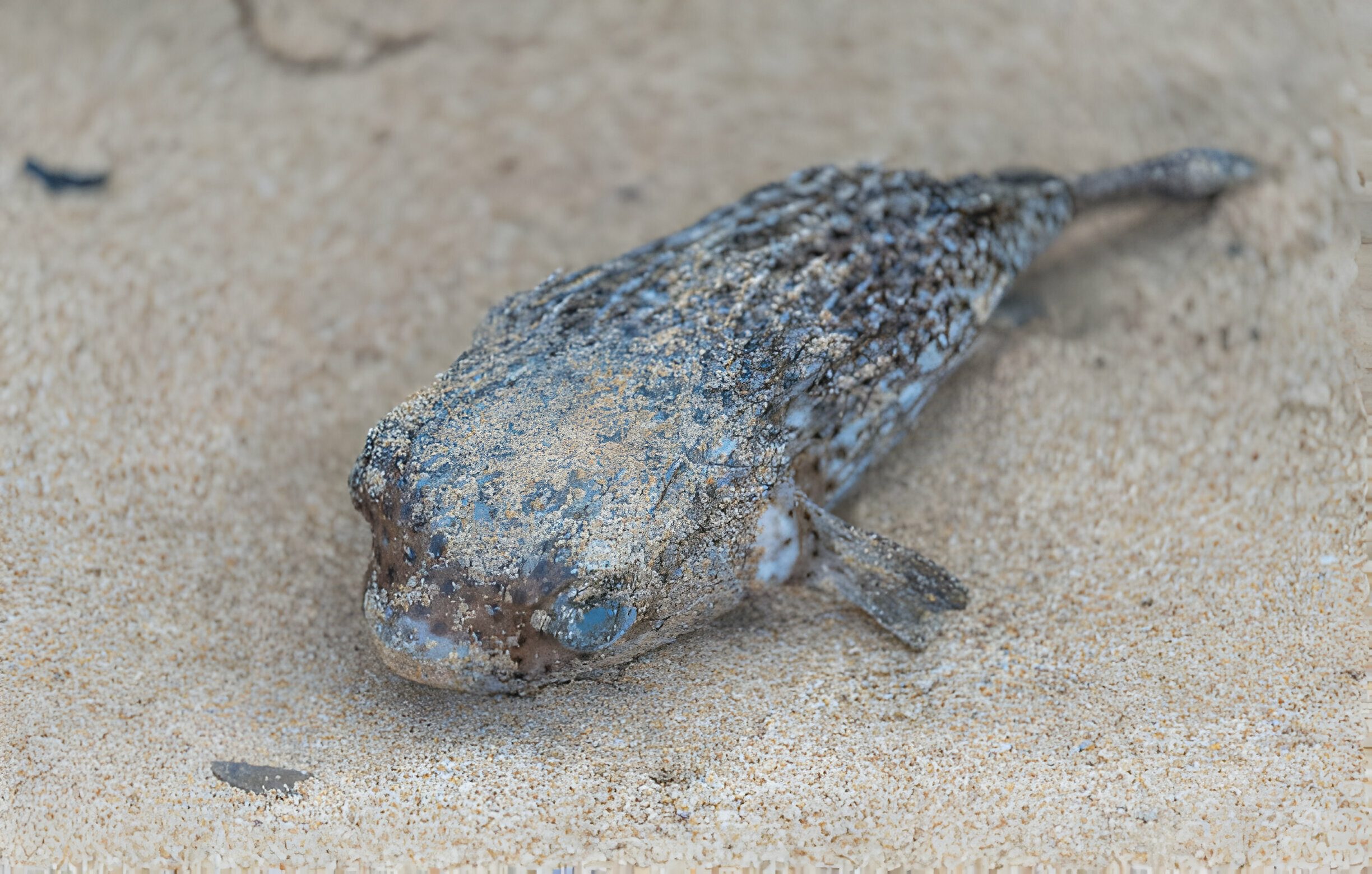This morning, reports have surfaced of pufferfish sightings along the beaches of Fish Hoek and Glencairn. Residents and visitors are advised to refrain from handling these pufferfish due to the presence of the neurotoxin tetrodotoxin, which can pose a significant health risk. It is also crucial to ensure that pets, particularly dogs, do not come into contact with the fish. In the event that a dog consumes a pufferfish, immediate assistance should be sought from the nearest veterinarian.
This occurrence may trigger memories for some Capetonians of a similar event approximately two years ago, also observed in March. During that time, a notable influx of pufferfish, recognizable by their distinctive ‘evil eye’ appearance, washed up along the shores of False Bay, including beaches in Muizenberg and Fish Hoek. The City authorities responded by removing approximately 70 bags of these fish, totaling a weight of 200kg.
What are Pufferfish?
Pufferfish, also known as blowfish or fugu, are a fascinating group of fish renowned for their peculiar ability to inflate themselves into spiky spheres when threatened. However, beyond their remarkable appearance lies a hidden danger – their toxicity. Pufferfish contain a potent neurotoxin known as tetrodotoxin (TTX), which makes them one of the most poisonous vertebrates in the world.
Toxin and Mechanism
Tetrodotoxin is a potent neurotoxin that blocks sodium channels in nerve cells, leading to paralysis and potentially death. Even minute amounts of TTX can induce severe poisoning in humans, with symptoms ranging from numbness and dizziness to respiratory failure and death. Despite its lethality, TTX is produced by bacteria and accumulated by pufferfish, primarily in their liver, ovaries, and skin.
Distribution of Toxin
Different species of pufferfish vary in their toxicity levels, with some containing higher concentrations of TTX than others. The toxic parts of the pufferfish are predominantly the liver and ovaries, although the skin and other organs may also contain significant amounts of the toxin. Environmental factors, such as diet and habitat, can influence the accumulation of TTX in pufferfish populations.
Toxicity in Humans
Consumption of improperly prepared pufferfish dishes can lead to severe poisoning, known as tetrodotoxin poisoning or fugu poisoning. Symptoms typically manifest within hours after ingestion and may include nausea, vomiting, tingling sensations, and muscle paralysis. In severe cases, respiratory failure and death can occur within a matter of hours.
Are puffer fish venomous?
There is no specific antidote for TTX poisoning, and treatment primarily focuses on supportive care to manage symptoms and maintain vital functions. In cases of respiratory failure, mechanical ventilation may be necessary. Prompt medical intervention is crucial in improving the prognosis for individuals affected by pufferfish poisoning.
Is Pufferfish Safe?
Due to the significant health risks associated with consuming pufferfish, regulatory measures are in place in many countries to control its sale and preparation. Licensed chefs undergo rigorous training and certification before being permitted to prepare pufferfish dishes, ensuring that they possess the necessary skills to remove toxic organs safely.
Why is puffer fish so expensive?
Pufferfish are not as readily available as other types of fish, partly due to conservation efforts aimed at protecting their populations. Additionally, not all species of pufferfish are suitable for consumption, further limiting the availability of safe-to-eat varieties. As a result, the scarcity of pufferfish adds to their overall market value.
In Japan, consuming fugu is deeply ingrained in the country’s culinary culture and is often regarded as a prestigious dining experience. Demand for fugu tends to surge during certain seasons or special occasions, further driving up prices. The cultural significance attached to fugu, coupled with its perceived exclusivity, contributes to its elevated status as a luxury item in the culinary world.
Beyond its culinary appeal, the risks associated with consuming pufferfish also contribute to its high price. Despite stringent preparation techniques, there is always a level of inherent danger associated with consuming fugu. This risk factor, combined with the specialized skills required for safe handling, further justifies the premium price tag attached to pufferfish dishes.
In summary, the intricate preparation process, limited availability, cultural significance, and inherent risks associated with consumption all play a role in making pufferfish an expensive delicacy sought after by connoisseurs around the world.
Research and Mitigation Efforts
Ongoing research endeavors aim to better understand the factors influencing TTX production and accumulation in pufferfish, as well as develop more effective detection methods for the toxin. Mitigation efforts focus on raising awareness among consumers about the dangers of consuming pufferfish and implementing strict safety protocols within the culinary industry.
Is puffer fish safe to eat?
Despite the risks, pufferfish holds cultural significance in regions where it is consumed as a delicacy. In Japan, for example, fugu has been enjoyed for centuries, albeit with strict regulations governing its preparation and consumption. Efforts to raise awareness about the dangers of pufferfish poisoning are essential in ensuring public safety while preserving cultural traditions.
Is it safe to touch a Pufferfish?
If you are stung by a pufferfish, it’s crucial to seek medical attention immediately due to the potential severity of the injury. Here are some steps to take if you or someone else is stung by a pufferfish:
- Stay Calm: Panicking can worsen the situation by increasing heart rate and blood circulation, potentially spreading the toxin more rapidly throughout the body.
- Remove the Spines (if applicable): Some species of pufferfish have sharp spines that can cause injury if touched. If you’ve been stung by a pufferfish with spines, carefully remove any visible spines from the wound to prevent further injury or infection. Use tweezers or a similar tool and handle with caution to avoid accidentally pushing the spine deeper into the skin.
- Clean the Wound: Rinse the affected area thoroughly with clean water to remove any remaining traces of venom or foreign particles. Avoid using soap, as it may irritate the wound further.
- Apply Pressure and Elevate: If the sting is bleeding, apply gentle pressure to the wound with a clean cloth or bandage to help control bleeding. Elevate the affected limb above the level of the heart if possible to reduce swelling.
- Seek Medical Help: Regardless of the severity of symptoms, seek immediate medical attention. Pufferfish venom can cause serious complications, including paralysis and respiratory failure, which require prompt medical intervention.
- Monitor Symptoms: While waiting for medical help to arrive, monitor the person’s symptoms closely. Be prepared to provide information about the time of the sting, the species of pufferfish involved (if known), and any changes in the person’s condition.
- Do Not Attempt Home Remedies: Avoid applying ice, heat, or any other home remedies to the wound, as these may worsen the symptoms or delay proper medical treatment.
- Do Not Consume Alcohol or Caffeine: Alcohol and caffeine can potentially exacerbate the effects of the venom and should be avoided until medical assistance is received.
Remember, pufferfish stings can be life-threatening, and immediate medical attention is essential. Do not underestimate the seriousness of the situation, and prioritize seeking professional medical help as soon as possible.

















